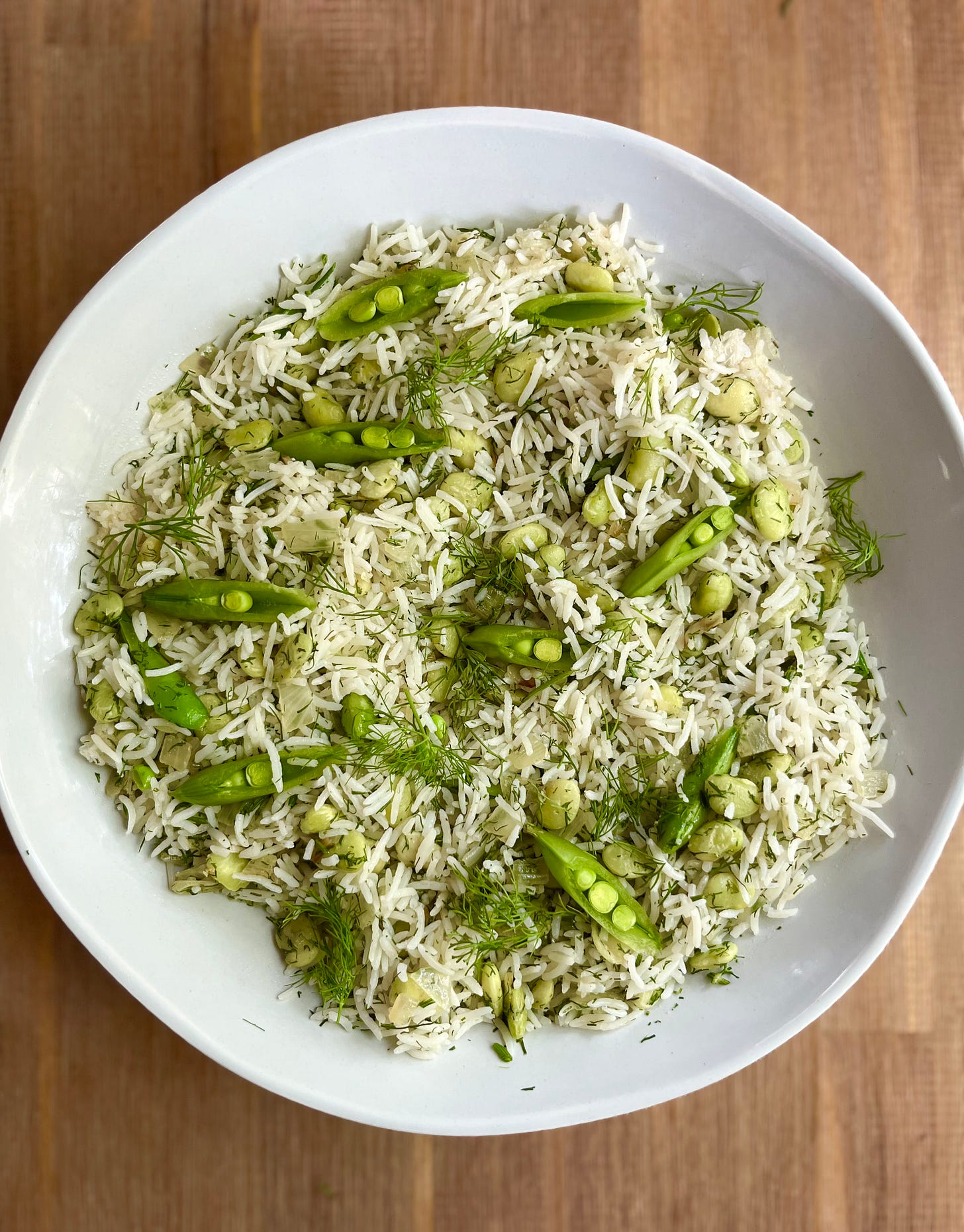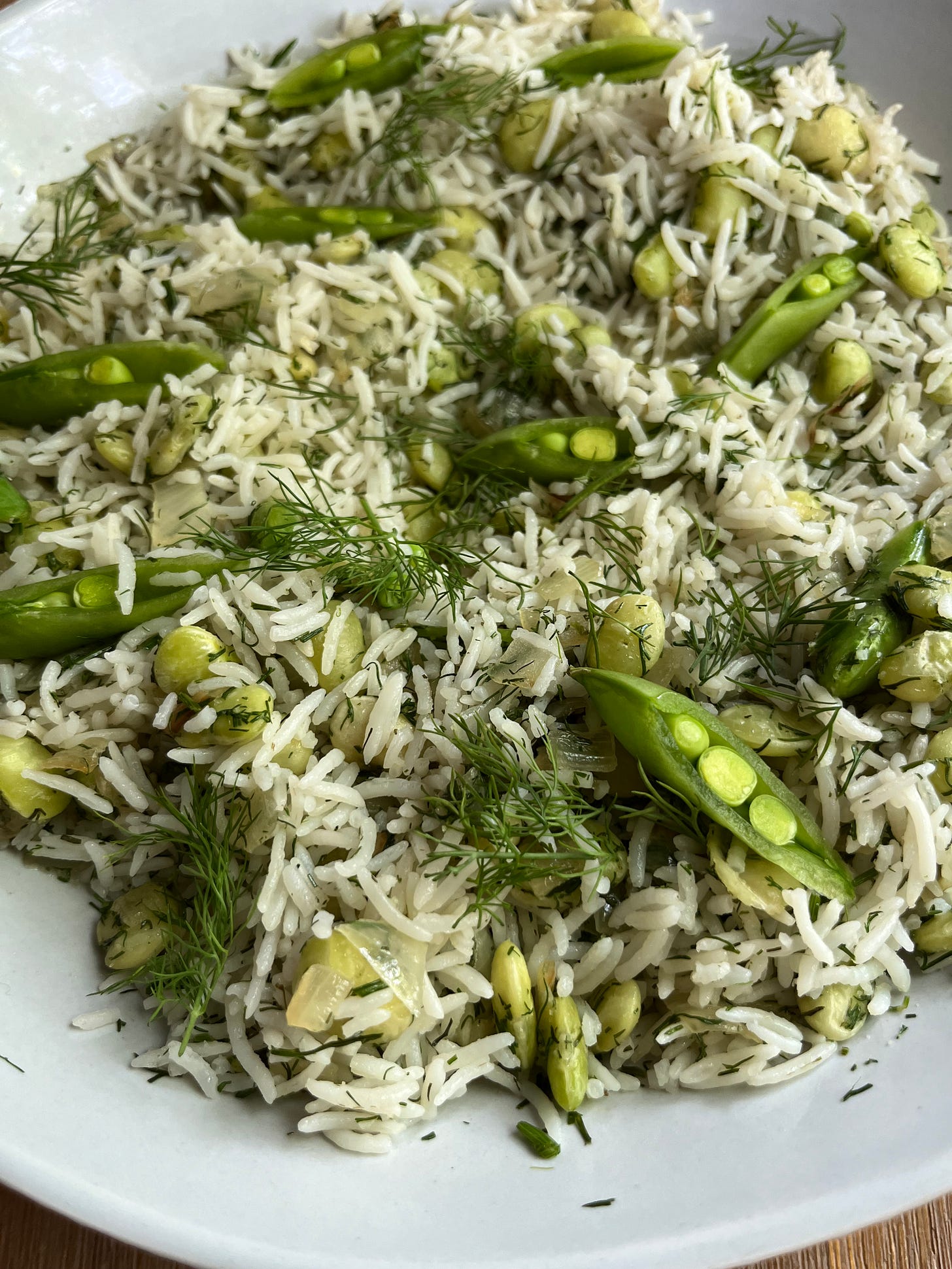One of my favorite things about Yoshie being a musician (aside from the joy of hearing him play) is that his work brings our family into contact with so many incredible people. People like Martin Shamoonpour—a woodwind player and percussionist from Iran (he grew up in Tehran and moved to America in 2015) who recently stayed at our home overnight before he and Yoshie flew to Europe for a couple of epic shows.
Martin was only at our house for 12-ish hours, but managed to charm the kids with his remarkably spot-on drawing of a cartoon dolphin playing the violin. And I was delighted to talk food with him—particularly about some of his favorite Iranian dishes. Our conversation reminded me of one of my favorite Persian recipes, baghali polo—rice with dill and fava beans—which I included in The Jewish Cookbook.
Persian cuisine has both a deep love for, and undeniable gift with, all things rice. And the relationship goes way back. According to the Encyclopedia of Jewish Food by Gil Marks, “In 515 BCE…the Persian Empire established a sea route to India and consolidated control over the Indus River valley.” Once there, they were introduced to rice—an ingredient they eagerly adopted into their cuisine and helped to spread across central Asia.
By the 15th century, polow—dishes of meat or vegetables that are mixed into or layered and steamed together with rice—had become, as Marks calls it, “an art form in Iran.” The artistry continues today with tahdig* (the golden, crunchy layer that forms at the bottom of Persian rice cooking pot), jeweled rice (which comes tinted with saffron and bedecked with pistachios and pomegranates), and many other celebratory pilafs.
Baghali polo pairs fluffy, fragrant grains of basmati rice with steamed fava beans and heaps of chopped dill. (In Persian, baghalaa translates to fava and polo to pilaf.) The dish can be made with or without a tahdig layer and is often served alongside braised lamb shanks or other festive meat dishes. It is beloved by all Iranians, including Iranian Jews and for good reason: it is at once simple and spectacular.
To be clear: my recipe this week for Dilled Rice with Limas and Sugar Snaps is not traditional. It uses easier-to-find frozen lima beans rather than favas (if you think you don’t like limas, I have a feeling this dish will convert you!). It also introduces a few unorthodox flavors—like crunchy-sweet sugar snap peas—to the classic recipe.
After talking pilafs with Martin, I remembered another dish I love called Buttered Sweet Pea Rice, which comes from Canadian chef Anthony Rose’s decidedly not Persian cookbook, The Last Schmaltz. I mashed together my favorite elements of the two dishes and…well, let’s just say I’m not mad about. This Dilled Rice with Limas and Sugar Snaps is impressive enough for company, while easy enough to enjoy on a weeknight.
Adding a pat (or two or three) of butter to hot rice, as this recipe does, is the stuff of pure magic. As it melts, it coats the rice grains leaving them slick and full of rich flavor. A game changer. If you are vegan, you can swap in a good quality vegan butter—but otherwise, don’t skip the butter. Kosher keepers, save this dish for a dairy meal (it would be excellent alongside roasted salmon) and enjoy!
*Speaking of Persian rice: in case you missed it, here is my ode to the Pars Rice Cooker, which makes achieving a gorgeous tahdig layer on your pot of rice almost too easy.
Shabbat Supper Club with Portico x Gertie (THIS FRIDAY)
Thanks to everyone who already booked your table for this Friday’s (7/12) Portico-inspired Shabbat Dinner at Gertie in Brooklyn. If you haven’t had a chance to get your tickets yet, head to the reservation link and claim your seat.
I’m super excited about the Roman Jewish-themed menu, and always love the opportunity to hang out at Gertie. Looking forward to seeing you there.
Book your table!
Dilled Rice with Limas and Sugar Snaps
Serves 6 to 8
Keep reading with a 7-day free trial
Subscribe to The Jewish Table to keep reading this post and get 7 days of free access to the full post archives.






